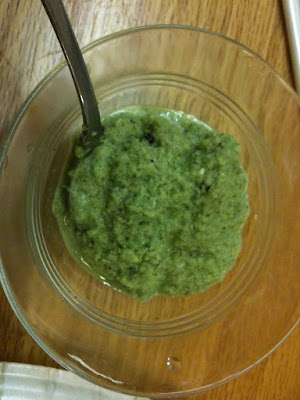I am currently staying in my lovely and generous brother's apartment. A lover of all things Italian, his presence pervades the space, and so I felt inspired to create a dinner involving flavors from that delectable boot of Europe.
As a little amuse
bouche, some
onions agrodolce , courtesy of Mario
Batali.

For a main course, lamb
ragu with
papparadelle, served with a spoonful of ricotta and a sprinkling of mint.
For sides, two from
Food and Wine. A lovely spicy
rabe with anchovies and garlic. And an
eggplant camponatina, served room temperature, replete with pine nuts, salt packed capers, celery, and green olives.

These were all very good. Some perhaps even
delizioso. However, it was the dessert that this time sent me over the edge.
Also from
Food and Wine, it was a
dulce de leche torte, known as a
volador. And I loved it immediately when the recipe's description mentioned its rustic informal nature (meaning it could look a little funny and crumble when you sliced it.)
And it was a funny looking fellow, surprisingly savory with no sugar involved. It's crust was a four layer number made of thin, thin disks of an incredibly yolk heavy dough, each of which puffed up considerably (hence the name's reference to "flying up" in Italian) as it did it's brief stint in the oven.

After cooling, between each delicate, bubbly, bumpy layer, I spread a coating of a mix of
dulce de leche and water, before stacking another layer on top.

At the end, I sprinkled the top layer with powder sugar.

I then served slices of the room temperature torte with scoops of simple vanilla ice cream. It was stunning, if I do say so myself. The rich sweetness of the
dulce de leche playing in incredible tandem with the snap and crunch of that remarkably flavorful
eggy crust, with the creaminess of the vanilla ice cream coming in to add a little more moisture to the mix. Really, truly sweet.

The only thing perhaps sweeter in all of this was the view as we ate -

While I can't offer a recipe for the magic of this panorama, I can for the torte, which again comes from
Food and Wine.
Dulce de Leche Torte (Volador)IngredientsFor the pastry:-12 large egg yolks
-1 teaspoon whole milk*
-1/8 teaspoon salt
-1 1/2 cups all purpose flour
For the filling:-2 cups
dulce de leche-3 tablespoons water
-1 tablespoon confectioners sugar
*Not wanting to buy a big thing of whole milk just for this, I stealthily procured some from the bodega down the street. No, I didn't steal it; I just poured a small splash of the stuff into a coffee cup and paid the 75 cents for that. Really, it was less than the amount that someone who likes light coffee would use and I didn't even get any coffee out of the deal, so I feel no remorse.
Directions Make pastry:
1. Preheat oven to 400°F with rack in middle. Generously brush a large baking sheet with vegetable oil.
2. Stir together yolks, milk, and salt.
3. Put flour in a large bowl and make a well in center. Add yolk mixture to well and gently stir with a fork, gradually pulling in flour closest to egg mixture to make a paste. Knead in all of remaining flour with your hands to form a dough (dough will be very firm).
4. Transfer dough to a work surface and knead, lightly dusting with additional flour as necessary, until smooth and elastic, 8 to 10 minutes.
5. Flatten dough into a disk, then quarter and form each quarter into a ball.
6. Keeping remaining dough covered with a kitchen towel (not terry cloth), firmly roll out 1 piece on a clean surface into a 12-inch round, lifting and turning dough as necessary. (Dough will be slightly sticky but will lift up easily; round will be very thin with uneven edges.)
7. Transfer to baking sheet and bake until edge is golden and curls up, about 5 minutes. Carefully turn over and bake until cooked through and both sides are golden in some spots (lift to check), 3 to 4 minutes more. Transfer to a rack to cool.
8. Repeat with remaining dough. (Pastry will overlap on racks.)
Make filling:
1. Stir together dulce de leche and water in a bowl. If mixture is not spreadable, warm in a small heavy saucepan over medium-low heat, whisking until smooth. Thin with additional water if necessary.
Assemble torte:
1. Arrange 1 pastry layer on a serving plate and spread evenly with 2/3 cup filling. Repeat with 2 more pastry layers and remaining filling, stacking layers.
2. Dust remaining pastry layer with confectioners sugar and arrange on top.
3. To serve, cut or crack torte into portions using 2 large spoons.








.jpg)















































